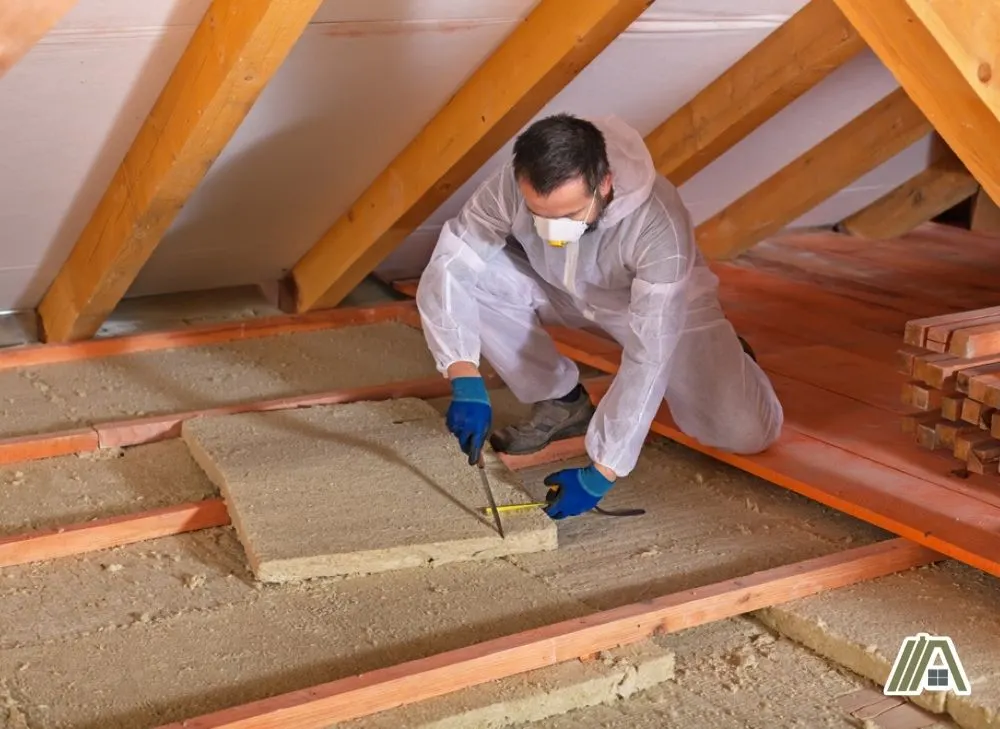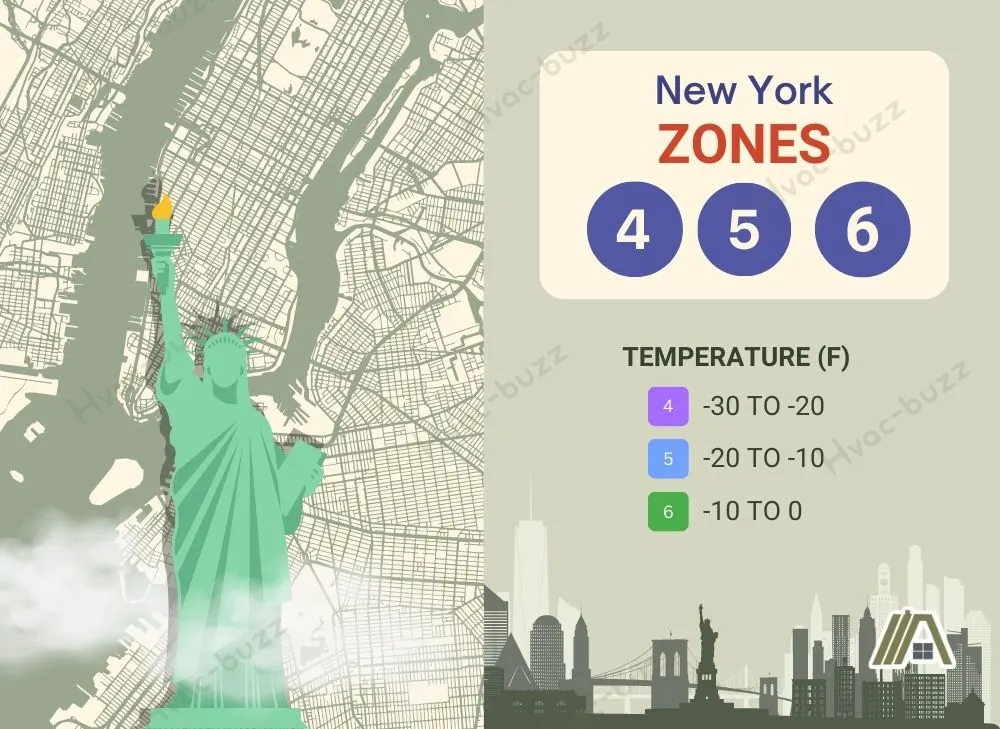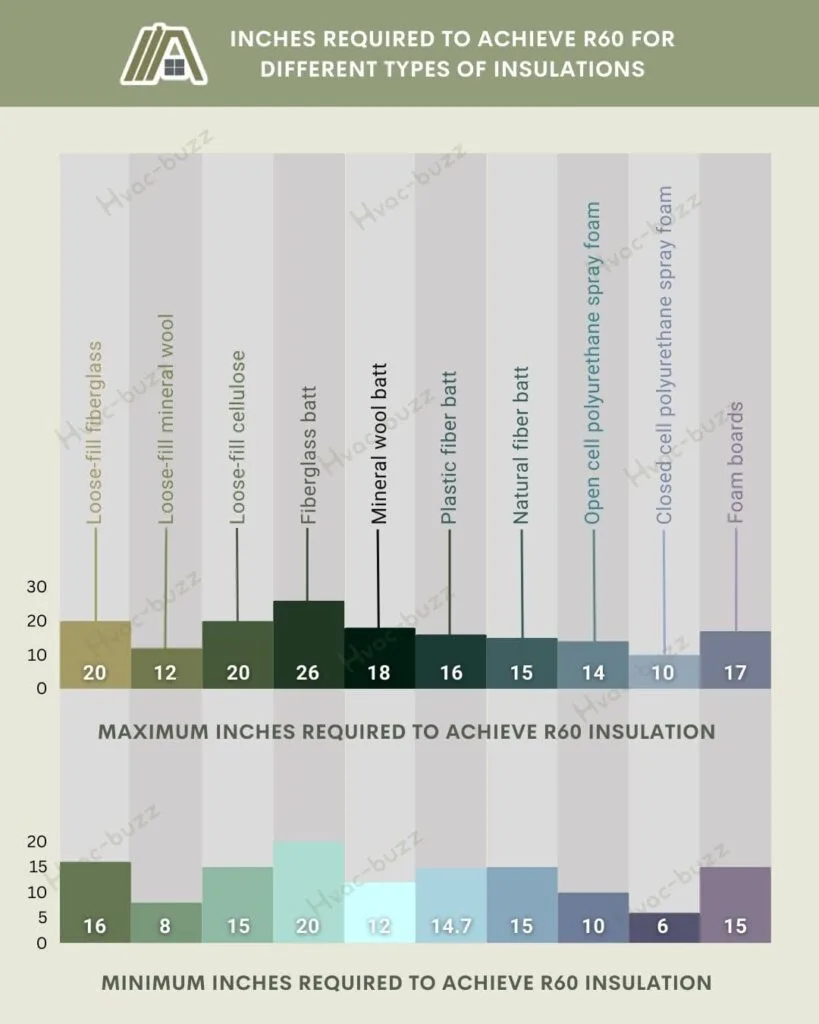According to the US Environmental Protection Agency (EPA), homeowners can save up to an average of 15% on heating and cooling costs (or an average of 11% on total energy costs) by sealing and insulating their homes.
The key to high-performing insulation is using the right insulation thickness for your project and climate. In this article, I provide information on the appropriate locations and climates for R60 insulation. I also provide a detailed thickness guide for the different insulation materials.

R60 insulation is necessary for ceilings/attics in moderately cold to freezing climates. The thinnest layer achieving R60 is 6-10" (closed cell spray foam polyurethane), and the thickest layer achieving is R60 16-20" (loose-fill fiberglass).
Not Many Places Require R60 Insulation
The R-value of an insulation material is used to measure its level of heat resistance, specifically to heat conduction.
The R-value required for your project would be determined by the installation location as well as the climate of your locality.
As a general rule, the higher the R-value of a material, the greater its thermal insulation performance.
R60 insulation is considered a heavy-duty rating and is only required in locations that need high levels of thermal resistance like extremely cold regions and uninsulated attics.
Depending on the insulation material and quality of installation, using R60 insulation can reduce heat loss by about 98%.
That being said, using R60 for a project that requires R30 to R49 insulation doesn’t guarantee superior thermal protection.
R60 Insulation Primarily Used in Attics/Ceilings
R60 insulation is designed for locations that require high thermal protection.
The upper areas of the house (ceilings and attics) are prone to temperature extremes throughout the year. As a result, they require greater thermal resistance than other locations like floors and walls.

They are the location where heat gathers and is lost, which makes them problematic all year round.
Unventilated or poorly ventilated ceilings or attics can account for about 25%-35% of the total heat loss in a house.
Hot air rises, so during the winter months, you might lose a substantial amount of conditioned air if your attic or ceiling isn’t properly insulated, resulting in an increase in energy expenses.
Only Some Climate Zones Require R60
States in the US are divided into climate zones based on the prevailing weather conditions in the regions.
Knowing your climate zone will help with choosing the right insulation material for your project.
Table N1102.1.3 of the International Residential Code (IRC) outlines the required R-values for the different climate zones. According to the table, R60 is required for ceiling insulation in zones 4, 5, 6, 7, and 8.
Compared to zones 1-3, zones 4-8 are characterized by cooler weather conditions. Hence, the need for the improved thermal resistance provided by R60 insulation.
As a general rule, higher climate zone figures indicate colder weather conditions.
Here is a look at the climate in the different zones listed for R60 insulation.
| Climate Zone | Prevailing Weather Conditions |
| Zone 4A | Mixed humid |
| Zone 4B | Mixed dry |
| Zone 4C | Mixed marine |
| Zone 5A | Cool humid |
| Zone 5B | Cool dry |
| Zone 5C | Cool marine |
| Zone 6A | Cold humid |
| Zone 6B | Cold dry |
| Zone 7 | Very cold |
| Zone 8 | Subarctic/arctic |
It’s important to note that climate zones overlap between states and your state can belong to multiple climate zones. For instance, New York includes zones 4, 5, and 6, while California has five different climate zones (2, 3, 4, 5, and 6).

To be safe, check with your local building code before proceeding with your project.
Examples of states that require R60 insulation include Alaska, Wyoming, Wisconsin, Michigan, Colorado, Washington, and New York.
R60 Insulation Thickness Guide: Table

| Insulation Type | Inherent R-value (per inch thickness) | Thickness to achieve R60 | Best-selling option |
| Loose-fill fiberglass | R3.1 | 16″-20″ | Owens Corning Atticat Expanding Fiberglass Insulation |
| Loose-fill mineral wool | R3.1 | 8″-12″ | ROCKWOOL Stone Wool Insulation Granulate |
| Loose-fill cellulose | R3.4 | 15″-20″ | ThermoFloc Loose Fill Cellulose Insulation |
| Fiberglass batt | R2.5 | 20″-26″ | Owens Corning Kraft Faced Fiberglass Insulation Batt |
| Mineral wool batt | R3.4 | 12″-18″ | Rockwool |
| Plastic fiber batt | R3.8 | 14.7″-16″ | Supersoft Recycled Plastic Insulation |
| Natural fiber batt | R3.4 | 15″ | UltraTouch Natural Cotton Fiber Batt Insulation |
| Open-cell polyurethane spray foam | R3.6 | 10″-14″ | Versi Foam Open Cell Spray Foam Kit |
| Closed-cell polyurethane spray foam | R6 | 6″-10″ | Heatlok HFO Pro Spray Foam Insulation |
| Foam boards | R5 | 15″-17″ | Owens Corning FOAMULAR Rigid Foam Board Insulation |
Diminishing Returns?
When comparing R60 and R49 insulation, the decision hinges on the balance between increased effectiveness and the additional cost. R60 insulation offers a higher R-value, stopping about 98% of heat loss, while R49 is slightly lower.
The higher the R-value, the better the insulation is at preventing heat transfer. However, the key question is whether the jump from R49 to R60 justifies the extra expense.
While R60 insulation provides increased resistance to heat transfer, it may not always result in a significantly higher level of effectiveness compared to R49. Factors such as the unique structure of your home, the color of roof shingles, roof ventilation, and sunlight exposure can impact the insulation’s overall performance.
If you live in an area with less extreme weather conditions, the difference between R49 and R60 may not be substantial enough to warrant the higher cost.
In essence, choosing between R60 and R49 involves assessing your specific climate, budget, and the structural characteristics of your home. If the climate necessitates R60 according to building codes, it might be a worthwhile investment.
However, if you’re considering it as an optional addition, carefully weigh the benefits against the cost to determine if the extra insulation value aligns with your needs and budget or if it represents diminishing returns for your particular situation.
Sources
https://www.energy.gov/sites/prod/files/guide_to_home_insulation.pdf
https://insulationinstitute.org/im-a-homeowner/about-insulation/how-much-do-i-need/

Robert Fizek
Tuesday 23rd of January 2024
R60 is fine if one is designing new construction, but is very challenging and problematic when working with existing homes where framing was not designed to allow for the depths needed. This encourages tear-downs of otherwise functional and often more compact and affordable homes. Which is terribly carbon costly, even if the new structure is net-zero it is many years to recover the combined embodied carbon costs for wasting the existing plus the new construction.
steve
Saturday 24th of February 2024
@Robert Fizek, I agree 100%, that which is already built / constructed is far greener than anything else we can do, even if it is not as efficient, it doesn't require the massive expenditure of new resources like the new construction does. This applies to so many areas today and I expressed this opinion when the Obama era 'cash 4 clunkers' program came into being, but no one listened.
Michael Scott
Wednesday 24th of January 2024
@Robert Fizek,
I appreciate your input on the challenges posed by R60 in existing homes, and I think it adds an important perspective to the article on sustainable construction.
Before including this aspect in the article, may I have your permission to do so?
Let me know your thoughts!